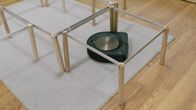
Your home has many hazards for a robot vacuum no matter how smart it is. Remove them so you can enjoy hassle-free automatic cleaning.
Robot vacuums
can be very helpful tools to have around the house. They’re designed to clean your floors automatically, even when you’re not home. Despite all of their sophisticated sensors and smart mapping systems, even the most advanced machines can get stuck on thick rugs, tangled around cords or hopelessly lost. Before you set a robot vacuum free to roam, you can help ensure it completes the job by preparing your home properly.
Read more: Best robot vacuum of 2021: iRobot Roomba, Neato and more
Stay in the know
Get the latest tech stories with PJDM Daily News every weekday.
Don’t worry, the tips I’ll lay out here are simple. With these potential pitfalls removed, you’ll be able to kick back and relax while your robot does all the work.
Make sure the dock for your robot vacuum has plenty of room around it.
Step 1: Give the dock lots of room
A robot vacuum’s docking station serves many vital functions. It charges its battery so the vacuum is ready to clean at a moment’s notice. The dock also acts as a home base, and a reference point the robot uses to triangulate its relative position in a room. iRobot’s latest Roombas have bases that even empty and collect their vacuum’s dustbins.
Watch this:
Lasers, sensors and robots, oh my: Some robot vacuums…
3:43
Pick a spot for your dock with care, a location with plenty of room for your robot to maneuver so it can line up with the base correctly when it want to redock for a battery charge. The exact amount of clearance each manufacturer recommends may differ. Still, expect to have anywhere between 1.5 to 3 feet of open area on either side of the dock. Likewise, clear at least 4 feet of empty space in front of the dock.
It’s also a bad idea to drop your dock close to flights of stairs. You’ll not only create a trip hazard, but the cramped area will likely confuse your vacuum.
Small, hard, and sharp objects can do big damage to your robot vacuum.
Step 2: Clear away tiny hazards
Small, hard, and especially sharp objects are bad news for any robot vacuum. Items like metal nails, screws, even plastic Lego pieces can cause big headaches. They could damage internal vacuum components, and possibly mar or scratch expensive flooring. Make sure to keep an eye out for these potential before they become an issue.
A nest of cables like this can stop a robot vacuum in its tracks.
Step 3: Tidy up messy cords
Unruly cords and wires have long been troublesome for robot vacuums. The spinning wheels, and brushes of robotic cleaners often wrap themselves around these obstructions. Minimize that risk by organizing and securing them.
The less mess your cords and cables make, the less likely your vacuum will be tangled by them.
Areas that can be especially problematic are living room entertainment centers, home offices, and bedroom nightstands. Check out our guide for ideas about how you can cut down on TV cord clutter. You can also see up-close products I personally tried that work well to eliminate my messy cord situation.
Water and robots don’t mix. Clear or block access to pet water bowls and potted house plants.
Step 4: Watch out for water
Water and electronics don’t mix, and that’s definitely true of robot vacuums. The last thing you want your pricey robot to do is suck up moisture from wet floors. If water enters critical sections such as sensors, circuitry, or the electric motor, your vacuum may suffer irreparable damage.
Keep it away from pet drinking bowls or objects that may contain water such as plant planters and pots. You can do that by placing no-go barriers virtually in the app if your robot supports the feature. Another way to go is to drop a physical virtual wall device. iRobot bundles gadgets like this with its Roomba products: They beam invisible infrared light barriers Roombas will not cross.
Thick area rugs often trap robot vacuums.
Step 5: Beware the threat of shag rugs
Plush area rugs can be comfortable to walk on, but they often act as a traps for a robot vacuum. Few robots can cross rugs that are woven from long fibers, or even ones that have tassels, without becoming stuck.
Consider rolling them up before cleaning, or taping down tassles to make them less likely to tangle. Either that or restrict your robot vacuum’s access to these rugs. You can block them off with physical barriers, or virtual ones, depending on the bot. Other options include using magnetic tape or virtual wall accessories, both of which may have been included in the box with your robot vac.
If your robot vacuum uses a LIDAR laser navigation system like the Neato Botvac D7 Connected shown here then it can run in complete darkness. If it has an optical sensor like iRobot Roombas, leave a light on for it.
Step 6: Leave a light on
iRobot Roombas and some Ecovacs Deebot models rely on a main optical sensor to get around. That means if there’s not enough ambient light, they’ll have trouble seeing obstacles and navigating properly through rooms.
Some robot vacuums have a better sense of direction than others
See all photos
Most robot vacuum owners will clean when no one is home. Even so, if your robot uses this type of sensor system remember to leave a light on or open a shade or two.

Leave a Reply